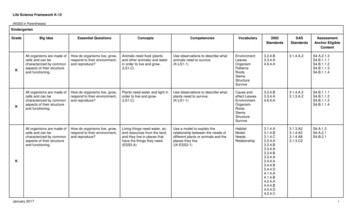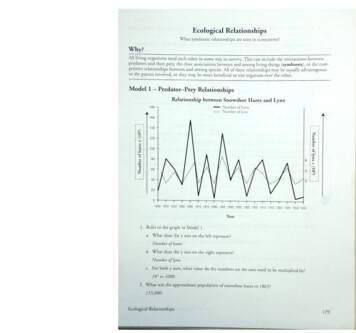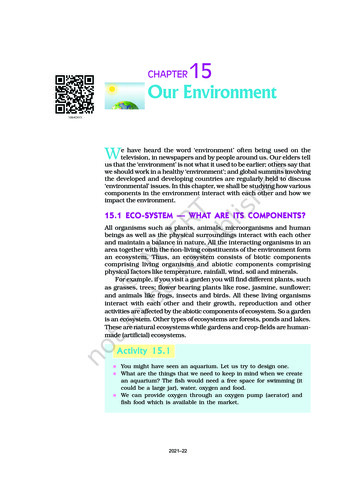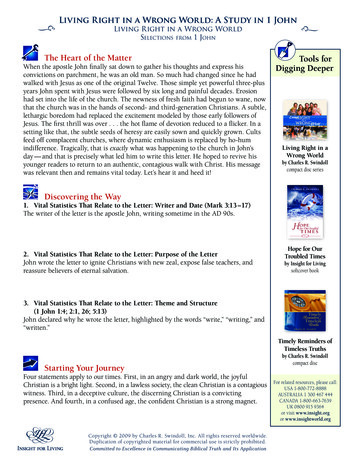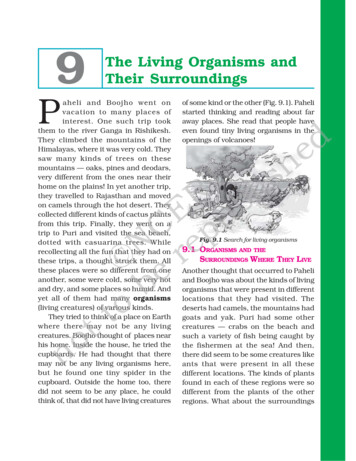
Transcription
9PThe Living Organisms andTheir Surroundingsaheli and Boojho went onvacation to many places ofinterest. One such trip tookthem to the river Ganga in Rishikesh.They climbed the mountains of theHimalayas, where it was very cold. Theysaw many kinds of trees on thesemountains — oaks, pines and deodars,very different from the ones near theirhome on the plains! In yet another trip,they travelled to Rajasthan and movedon camels through the hot desert. Theycollected different kinds of cactus plantsfrom this trip. Finally, they went on atrip to Puri and visited the sea beach,dotted with casuarina trees. Whilerecollecting all the fun that they had onthese trips, a thought struck them. Allthese places were so different from oneanother, some were cold, some very hotand dry, and some places so humid. Andyet all of them had many organisms(living creatures) of various kinds.They tried to think of a place on Earthwhere there may not be any livingcreatures. Boojho thought of places nearhis home. Inside the house, he tried thecupboards. He had thought that theremay not be any living organisms here,but he found one tiny spider in thecupboard. Outside the home too, theredid not seem to be any place, he couldthink of, that did not have living creaturesof some kind or the other (Fig. 9.1). Pahelistarted thinking and reading about faraway places. She read that people haveeven found tiny living organisms in theopenings of volcanoes!ondehsTilRbEuCpeNr ebottFig. 9.1 Search for living organisms9.1 ORGANISMS AND THESURROUNDINGS WHERE THEY LIVEAnother thought that occurred to Paheliand Boojho was about the kinds of livingorganisms that were present in differentlocations that they had visited. Thedeserts had camels, the mountains hadgoats and yak. Puri had some othercreatures — crabs on the beach andsuch a variety of fish being caught bythe fishermen at the sea! And then,there did seem to be some creatures likeants that were present in all thesedifferent locations. The kinds of plantsfound in each of these regions were sodifferent from the plants of the otherregions. What about the surroundings
in these different regions? Were theythe same?will discuss the table as we travelthrough many more interesting places.Activity 19.2 HABITAT AND ADAPTATIONLet us start with a forest. Think of allthe plants, animals and objects that canbe found there. List them in Column 1of Table 9.1. List things, animals andplants, found in the other regions thatare also shown in the table. You cancollect the examples scattered throughthis chapter to fill Table 9.1. Discussalso with your friends, parents andteachers, to find more examples to fillthe tables. You can also consult manyinteresting books in libraries that talkof animals, plants and minerals ofdifferent regions.T ry and include many plants,animals and objects, big and small, ineach of the columns in this table. Whatkind of objects will we find that may notbe animals or plants? Perhaps parts ofplants like dried leaves, or parts ofanimals, like bones. We may also finddifferent kinds of soils and pebbles.Water in the oceans may have saltsdissolved in it as discussed in Chapter5. There could be many more objects.As we go through the chapter, keepadding more examples to Table 9.1. WeWhat do you find from the plants andanimals listed in Activity 1? Did you finda large variety in them? Look at what youhave entered in the column for the desertand the column for the sea in Table 9.1.Did you list very different kind oforganisms in these two columns?What are the surroundings like, inthese two regions?In the sea, plants and animals aresurrounded by saline (salty) water. Mostof them use the air dissolved in water.There is very little water available inthe desert. It is very hot in the day timeand very cold at night in the desert. Theanimals and plants of the desert live onthe desert soil and breathe air from thesurroundings.The sea and the desert are verydifferent surroundings and we find verydifferent kind of plants and animals inthese two regions, isn’t it? Let us lookat two very different kinds of organismsfrom the desert and the sea – a cameland a fish. The body structure of a camelhelps it to survive in desert conditions.Camels have long legs which help todehsTilRbEuCpeNr ebottonTable 9.1 Animals, plants and other objects found in different surroundingsIn the forest80On mountainsIn the desertIn the seaAny other?SCIENCE
keep their bodies away from the heat ofthe sand (Fig. 9.2). They excrete smallamount of urine, their dung is dry andthey do not sweat. Since camels losevery little water from their bodies, theycan live for many days without water.Let us look at different kinds of fish.Some of these are shown in Fig. 9.3.There are so many kinds of fish, but, doyou see that they all have somethingcommon about their shape? All the onesshown here have the streamlined shapethat was discussed in Chapter 8. Thisshape helps them move inside water.Fish have slippery scales on their bodies.These scales protect the fish and alsohelp in easy movement through water.We discussed in Chapter 8, that fishhave flat fins and tails that help themto change directions and keep their bodybalance in water. Gills present in thefish help them to use oxygen dissolvedin water.We see that the features of a fish helpit to live inside water and the features ofa camel help it to survive in a desert.We have taken only two examplesfrom a very wide variety of animals andplants that live on the Earth. In all thisvariety of organisms, we will find thatthey have certain features that helpthem live in the surroundings in whichthey are normally found. The presenceof specific features or certain habits,which enable a plant or an animal tolive in its surroundings, is calledadaptation. Different animals areadapted to their surroundings indifferent ways.The surroundings where organismslive is called a habitat. The organismsdepend for their food, water, air, shelterand other needs on their habitat.Habitat means a dwelling place (ahome). Several kinds of plants andanimals may share the same habitat.The plants and animals that live onland are said to live in terrestrialhabitats. Some examples of terrestrialhabitats are forests, grasslands, deserts,coastal and mountain regions. On theother hand, the habitats of plants anddehsTilRbEuCpeNr ebottonFig. 9.2 Camels in their surroundingsTHE LIVING ORGANISMS AND THEIR SURROUNDINGSFig. 9.3 Different kinds of fish81
There are some changes that can happen in an organism over a short periodof time to help them adjust to some changes in their surroundings. For instance,if we live in the plains and suddenly go to high mountain regions, we mayexperience difficulty in breathing and doing physical exercise for some days.We need to breathe faster when we are on high mountains. After some days,our body adjusts to the changed conditions on the high mountain. Suchsmall changes that take place in the body of a single organism over shortperiods, to overcome small problems due to changes in the surroundings, arecalled acclimatisation. These changes are different from the adaptations thattake place over thousands of years.dehsTilRbEuCpeNr ebottanimals that live in water are calledaquatic habitats. Ponds, swamps,lakes, rivers and oceans are someexamples of aquatic habitats. There arelarge variations in forests, grasslands,deserts, coastal and mountain regionslocated in different parts of the world.This is true for all aquatic habitatsas well.The living things such as plantsand animals, in a habitat, are its bioticcomponents. Various non-living thingssuch as rocks, soil, air and water inthe habitat constitute its abioticcomponents. Sunlight and heatalso form abiotic components ofthe habitat.We know that some plants grow fromseeds. Let us look at some abiotic factorsand their effect on seeds as they growinto young plants.onActivity 2Recall Activity 5 in Chapter 1 — we madesprouts from moong and chana seeds.When the seed turned into a sprout, itgerminated. This was the beginning ofa new plant, from the seed.82Collect some dry moong seeds. Keepa small heap of seeds aside and soakthe rest in water for a day. Divide thesoaked seeds into four parts. Keep onepart completely submerged in water for3-4 days. Do not disturb the dry seedsand those submerged in water. Keep onepart of soaked seeds in a sunny roomand another in a completely darkregion like a cupboard that does notallow any light to come in. Keep the lastpart in very cold surroundings, say, ina refrigerator or with ice around them.Set these three parts to germinate byrinsing them and draining the waterevery day. What do you notice, after afew days? Do the seeds in all the fiveparts germinate equally? Do you findslower or no germination in anyof these?Do you find that abiotic factors likeair, water, light and heat are veryimportant for growth of plants. In fact,these abiotic factors are important forall living organisms.We find that organisms exist in verycold as well as very hot climates andsurroundings, isn’t it? How do theySCIENCE
manage to survive? That is where,adaptation comes in.Adaptation does not take place in ashort time. Over thousands of years, theabiotic factors of a region change. Thoseanimals which cannot adapt to thesechanges die out, and only the adaptedones survive. Animals adapt to differentabiotic factors in different ways. Theresult is variety of organisms present indifferent habitats.Let us look at some habitats, theabiotic factors of these, and theadaptations of animals to these habitats.dehsTilRbEuCpeNr ebottFig. 9.4 Desert animals in burrows9.3 A JOURNEY THROUGH DIFFERENTHABITATSSome Terrestrial HabitatsDesertsWe discussed the abiotic factors of adesert and the adaptations in camelsto these. What about other animalsand plants that are found in deserts?Do they have the same kind ofadaptations?There are desert animals like ratsand snakes, which do not have the longlegs that the camel has. To stay awayfrom the intense heat during the day,they stay in burrows deep in the sand(Fig 9.4). These animals come out onlyduring the night, when it is cooler.Fig. 9.5 shows some typical plantsthat grow in a desert. How are theseadapted to the desert?onActivity 3Bring a potted cactus and a leafy plantto the classroom. Tie polythene bags toTHE LIVING ORGANISMS AND THEIR SURROUNDINGSFig. 9.5 Some typical plants that grow in desertsome parts of the two plants, as wasdone for Activity 4 in Chapter 7, wherewe studied transpiration in plants.Leave the potted plants in the sun andobserve after a few hours. What do yousee? Do you notice any difference in theamount of water collected on the twopolythene bags?Desert plants lose very little waterthrough transpiration. The leaves indesert plants are either absent, verysmall, or they are present in the shapeof spines. This helps in reducing loss ofwater from the leaves throughtranspiration. The leaf-like structureyou see in a cactus is, in fact, its stem(Fig. 9.5). Photosynthesis in these plants83
is usually carried out by the stems. Thestem is also covered with a thick waxylayer, which helps to retain water. Mostdesert plants have roots that go verydeep into the soil for absorbing water.Mountain regionsThese habitats are normally very coldand windy. In some areas, snowfall maytake place in winters.There is a large variety of plants andanimals living in the mountain regions.Have you seen the kind of trees shownin Fig. 9.6?also present on mountains. They mayhave different kind of adaptations tosurvive on the mountains.Animals living in the mountain regionsare also adapted to the conditions there(Fig. 9.7). They have thick skin or fur toprotect them from cold. For example, yakshave long hair to keep them warm. Snowleopard has thick fur on its bodydehsTilRbEuCpeNr ebott(a)Fig. 9.6 Trees of a mountain habitatIf you live in a mountain region orhave visited one, you may have seen alarge number of such trees. But, haveyou ever noticed such trees naturallygrowing in other regions?How are these trees adapted to theconditions prevailing in their habitat?These trees are normally cone shapedand have sloping branches. The leavesof some of these trees are needle-like.This helps the rainwater and snow toslide off easily. There could be trees withshapes very different from these that areon84(b)Fig. 9.7 (a) Snowleopards, (b) yakand (c) mountaingoats are adaptedto mountainhabitats(c)SCIENCE
including feet and toes. This protects itsfeet from the cold when it walks on thesnow. The mountain goat has stronghooves for running up the rocky slopesof the mountains.As we go up in the mountainousregions, the surroundings change andwe see different kinds of adaptations atdifferent heights.survive? It’s light brown colour helps itto hide in dry grasslands when it huntsfor prey (animals to eat). The eyes infront of the face allow it to have a correctidea about the location of its prey.A deer is another animal that lives inforests and grasslands. It has strong teethfor chewing hard plant stems of theforest. A deer needs to know about thepresence of predators ( animals like lionthat make it their prey ) in order to runaway from them and not become theirprey. It has long ears to hear movementsof predators. The eyes on the side of itshead allow it to look in all directions fordanger. The speed of the deer helps themto run away from the predators.There are many other features of alion, a deer or other animals and plantsthat help them to survive in theirhabitat.dehsTilRbEuCpeNr ebottGrasslandsA lion lives in a forest or a grasslandand is a strong animal that can huntand kill animals like deer. It is lightbrown in colour. Look at the picture ofa lion and that of a deer (Fig. 9.8). Howare the eyes placed in the face for thesetwo animals? Are they in the front oron the side of the face? Lions have longclaws in their front legs that can bewithdrawn inside the toes. Do thefeatures of a lion help it in any way toSome Aquatic Habitatson(a)(b)Fig. 9.8 (a) Lion and (b) deerTHE LIVING ORGANISMS AND THEIR SURROUNDINGSOceansWe already discussed how fish areadapted to live in the sea. Many othersea animals have streamlined bodies tohelp them move easily in water. Thereare some sea animals like squids andoctopus, which do not have thisstreamlined shape. They stay deeper inthe ocean, near the seabed and catchany prey that moves towards them.However, when they move in water theymake their body shapes streamlined.These animals have gills to help themuse oxygen dissolved in water.There are some sea animals likedolphins and whales that do not have85
gills. They breathe in air throughnostrils or blowholes that are locatedon the upper parts of their heads. Thisallows them to breathe in air when theyswim near the surface of water. They canstay inside the water for a long timewithout breathing. They come out to thesurface from time to time, to breathe inair. Did you ever see this interestingactivity of dolphins in televisionprogramme or films on ocean life?absorption of nutrients and water fromthe soil. However, in aquatic plants, rootsare much reduced in size and their mainfunction is to hold the plant in place.The stems of these plants are long,hollow and light. The stems grow up tothe surface of water while the leaves andflowers, float on the surface of the water.Some aquatic plants are totallysubmerged in water. All parts of suchplants grow under water. Some of theseplants have narrow and thin ribbon-likeleaves. These can bend in the flowingwater. In some submerged plants, leavesare often highly divided, through whichthe water can easily flow withoutdamaging them.Frogs usually have ponds as theirhabitat. Frogs can stay both inside thepond water as well as move on land.They have strong back legs that helpthem in leaping and catching their prey.They have webbed feet which help themswim in water.We have discussed only a fewcommon animals and plants comparedto the wide variety that live in thedifferent habitats. You may have alsonoticed the very wide variety in plantsaround you, when you prepared aherbarium as part of the suggestedactivities in Chapter 7. Imagine the kindof variety that you could see in aherbarium of leaves of plants from allregions of the Earth!dehsTilRbEuCpeNr ebottPonds and lakesHave you seen plants growing in ponds,lakes, rivers and even some drains? Goon a field trip to a nearby pond, if possible,and try to draw the kinds of plants thatare seen there. How are the leaves, stemsand roots of these plants placed?Some of these plants have their rootsfixed in the soil below the water(Fig. 9.9). In terrestrial plants, rootsnormally play a very important role in theonFig. 9.9 Some aquatic plants float on water.Some have their roots fixed in the soil at thebottom. Some aquatic plants are compltelysubmerged in water.869.4 LIVING THINGS AROUNDUSWe went on a journey through differenthabitats and discussed many plants andSCIENCE
animals. In Activity 1, we listed objects,plants and animals found in differentsurroundings. Suppose we stop a whileand think which examples in our listare living? Let us think of examples froma forest. Trees, creepers, small and biganimals, birds, snakes, insects, rocks,soil, water, air, dry leaves, dead animals,mushrooms and moss may be only someof the objects that are present in theforest. Which of these are living?Think of objects that you can seearound you at this moment and groupthem as living and non-living. In somecases, it is easy for us to know. Forexample, objects like chair or a table inour homes we know that they are notalive. Paheli was reading this rhymefrom Complete Nonsense written byEdward Lear:Paheli and Boojho found the poemso very funny, because they knew thata chair or a table is not alive and itcannot talk, walk or suffer from theusual problems that all of us face.A chair, table, stone or a coin. Weknow that they are not alive. Similarly,we do know that we are alive and so areall the people of the world. We also seeanimals around us that are so full oflife — dogs, cats, monkeys, squirrels,insects and many others.How do we know that something isliving? Often, it is not so easy to decide.We are told that plants are living things,but they do not appear to move like adog or a pigeon. On the other hand, acar or a bus can move, still we considerthem as non-living. Plants and animalsappear to grow in size with time. Butthen, at times, clouds in the sky alsoseem to grow in size. Does it mean thatclouds are living? No! So, how does onedistinguish between living and nonliving things? Do living things havesome common characteristics thatmake them very different from thenon-living?You are a wonderful example of a livingbeing. What characteristics do you havewhich make you different from a nonliving thing? List a few of thesecharacteristics in your notebook. Look atyour list and mark those characteristicsthat you have listed, which may also befound in animals or plants.Some of these characteristics areperhaps common to all living things.dehsTilRbEuCpeNr ebotte Chair,able to thSaid the Tware,ardly be a’You can he heat,er from th’How I suffmy feet!ilblains onhcmofr’Andlk,a little wa’If we tookle talk!have a litt’We mightair!’s take the’Pray let uChair.able to theSaid the Ttable,ehair to thSaid the Cnot able!rew we aonkuoy’Nowlk,shly you ta!’’How foolinnot walknow we cakuoyne’Wha sigh,able withSaid the Ttry,no harm to’It can doou,ysny legs a’I’ve as matwo?’noe walkw’tnacy’WhonTHE LIVING ORGANISMS AND THEIR SURROUNDINGS87
Do all living things need food?In Chapters 1 and 2, we learnt that allliving things need food and howessential it is to animals and to us. Wehave also learnt that plants make theirown food through the process ofphotosynthesis. Animals depend onplants and other animals for their food.Food gives organisms the energyneeded for them to grow. Organisms alsoneed this energy for other life processesthat go on inside them.pups of a dog growinto adults. Achicken hatchedfrom an egg, growsinto a hen or a cock.(Fig 9.11).Plants also grow.Look around youand see a few plantsof a particular type.Some are very smalland young, some Fig. 9.11 A chickenare grown. They grows into an adultmay all be in different stages of growth.Look at the plants after a few days andweeks. You may find that some of themhave grown in size. Growth seems to becommon to all living things.Do you think, non-living thingscannot show growth?dehsTilRbEuCpeNr ebottDo all living things showgrowth?Does the kurta you had four years back,still fit you? You cannot wear it anymore, isn’t it? You must have growntaller during these years. You may notrealise it, but you are growing all thetime and in few more years you willbecome an adult. (Fig 9.10).Young ones of animals also grow intoadults. You would surely have noticedonFig. 9.10 A baby grows into an adult88Do all living things respire?Can we live without breathing? Whenwe inhale, the air moves from outside tothe inside of the body. When we breatheout, the air moves from inside our bodyto outside. Breathing is part of a processcalled respiration. In respiration, someof the oxygen of the air we breathe in, isused by the living body. We breatheout the carbon dioxide produced in thisprocess.The process of breathing in animalslike cows, buffaloes, dogs or cats issimilar to humans. Observe any one ofthese animals while they are taking rest,and notice the movement of theirabdomen. This slow movement indicatesthat they are breathing.SCIENCE
Respiration is necessary for all livingorganisms. It is through respiration thatthe body finally obtains energy from thefood it takes.Some animals may have differentmechanisms for the exchange of gases,which is a part of the respiration process.For example, earthworms breathethrough their skin. Fish, we have learnt,have gills for using oxygen dissolved inwater. The gills absorb oxygen from theair dissolved in water.Do plants also respire? Exchange ofgases in plants mainly takes placethrough their leaves. The leaves take inair through tiny pores in them and usethe oxygen. They give out carbondioxide to the air.We learnt that in sunlight, plantsuse carbon dioxide of air to producetheir own food and give out oxygen.Plants produce their food only duringthe daytime whereas respiration inthem takes place day and night. Theamount of oxygen released in theprocess of food preparation by plantsis much more than the oxygen they usein respiration.they adjust to the changed brightsurroundings. Your favourite food,bright light and a thorn, in the abovesituations are some examples of changesin your surroundings. All of us respondimmediately to such changes. Changesin our surroundings that makes usrespond to them, are called stimuli.Do other animals also respond tostimuli? Observe the behaviour ofanimals, when the food is served tothem. Do you find them suddenlybecoming active on seeing the food?When you move towards a bird, whatdoes it do? Wild animals run away whenbright light is flashed towards them.Similarly, cockroaches begin to move totheir hiding places if the light in thekitchen is switched on at night. Can yougive some more examples of responsesof animals to stimuli?Do plants also respond to stimuli?Flowers of some plants bloom only atnight. In some plants flowers close aftersunset. In some plants like mimosa,commonly known as ‘touch-me-not’,leaves close or fold when someonetouches them. These are some examplesof responses of plants towards changesin their surroundings.dehsTilRbEuCpeNr ebottDo all living things respond tostimuli?onHow do you respond, if you suddenlystep on a sharp object like a thorn, whilewalking barefoot? How do you feel whenyou see or think about your favouritefood? You suddenly move from a darkplace into bright sunlight. Whathappens? Your eyes shut themselvesautomatically for a moment tillTHE LIVING ORGANISMS AND THEIR SURROUNDINGSActivity 4Place a potted plant in a room a littleaway from a window through whichsunlight enters some time during theday (Fig. 9.12). Continue watering theplant for a few days. Does the plant growupright, like plants out in the open?Note the direction in which it bends, if89
Do all living thingsreproduce theirown kind?Have you ever seen nestsof some birds likepigeons? Many birds laytheir eggs in the nest. Some of the eggsmay hatch and young birds come outof these (Fig. 9.13).dehsTilRbEuCpeNr ebottFig. 9.12 Plant respond to lightit is not growing upright. Do you think,this may be in response to somestimulus?All living things respond to changesaround them.Living organisms and excretionAll living things take food. Not all thefood that is eaten is really used, only apart of it is utilised by the body. Whathappens to the rest? This has to beremoved by the body as wastes. Our bodyalso produces some wastes in other lifeprocesses. The process of getting rid ofthese wastes by the living organisms isknown as excretion.Do plants also excrete? Yes, they do.However, the mechanisms in plants are alittle different. Some harmful or poisonousmaterials do get produced in plants aswastes. Some plants find it possible tostore the waste products within theirparts in a way that they do not harm theplant as a whole. Some plants removewaste products as secretions.Excretion is another characteristicscommon to all living things.(a)(b)Fig. 9.13 (a) Birds lay eggs which after hatchingproduce (b) young onesAnimals reproduce their own kind.The mode of reproduction may bedifferent, in different animals. Someanimals produce their young onesthrough eggs. Some animals give birthto the young ones (Fig. 9.14).Plants also reproduce. Like animals,plants also differ in their mode ofreproduction. Many plants reproducethrough seeds. Plants produce seeds,on90Fig. 9.14 Some animals which give birth totheir young onesSCIENCE
Living things produce more of theirown kind through reproduction. Ittakes place in many different ways, fordifferent organisms.Do all living things move?Fig. 9.15 A seed from a plant germinates into anew plantdehsTilRbEuCpeNr ebottwhich can germinate and grow into newplants (Fig.9.15).Some plants also reproduce throughparts other than seeds. For example, apart of a potato with a bud, grows into anew plant (Fig 9.16).Fig. 9.16 A new plant grows from a bud of potatoPlants also reproduce throughcuttings. Would you like to grow a plantin this way yourself?Activity 5In Chapter 8, we discussed the variousways in which animals move. They movefrom one place to another and also showother body movements.What about plants? Do they alsomove? Plants are generally anchored insoil so they do not move from one placeto another. However, various substanceslike water, minerals and the foodsynthesised by them moves from onepart of the plant to other. Have younoticed any other kind of movement inplants? Opening or closing of flowers?Do you recall how some plants showmovement in response to certainstimuli?We also have some non-livingthings moving, of course. A bus, car, asmall piece of paper, clouds and so on.Is there something different in thesemovements from the movements ofliving beings?There is such a variety of livingorganisms, but, all of them show somecommon characteristics, as we havediscussed. Yet another commoncharacteristic is that living beings die.Because organisms die, organism typescan survive over thousands of years onlyif they reproduce their own kind. Onesingle organism may die without everreproducing, but, the type of organismcan exist only if there is reproduction.onTake a cutting from a rose or a menhdiplant. Fix it in the soil and water itregularly. What do you observe, after afew days?It may not be easy to grow plants fromcuttings. Do not be disappointed if yourcutting does not grow. Talk to a gardner,if possible, on the care to be given tocuttings to make them grow into plants.THE LIVING ORGANISMS AND THEIR SURROUNDINGS91
We see that, all living things seem tohave some common characteristics.They all need food, respire, respond tostimuli, reproduce, show movement,grow and die.Do we find some non-living things thatalso show some of these characteristics?Cars, bicycle, clocks and the water inthe river move. The moon moves in thesky. A cloud grows in size right in frontof our eyes. Can such things be calledliving? We ask ourselves, do these objectsalso show all the other characteristicsof living things?In general, something that is livingmay have all the characteristics that wehave discussed, while non-living thingsmay not show all these characteristicsat the same time.Is this always true? Do we always findthat living things definitely show all thecharacteristics of the living that we havediscussed? Do we always find that nonliving things may show only some of thesecharacteristics and never all of them?To understand this a little better, letus look at a specific example. Considerany seed, say, moong. Is it living? It canstay in a shop for months and not showany growth or some of the othercharacteristics of life. However, we bringthe same seed and plant it in soil, waterit and it turns into a whole plant. Didthe seed — need food, did it excrete,grow or reproduce when it was in theshop for many months?We see that there can be cases whenwe cannot easily say that a thing has allthe characteristics that we have discussed,for it to be called living.dehsTilRbEuCpeNr ebotton92“What then is life?”Push your hand deep inside a sack ofwheat. Do you find it is warm inside?There is some heat being producedinside the sack of wheat. The seedsrespire and in that process give outsome heat.We see that respiration is a processthat takes place in seeds even whensome of the other life processes may notbe very active.It may not be very easy to answerour question — “what then is life”?However, looking at all the diversity ofliving beings around us, we canconclude that “life is beautiful”!AdaptationHabitatAquatic habitatLivingBiotic mulusSCIENCE
The surroundings where plants and animals live, is c
This is true for all aquatic habitats as well. The living things such as plants and animals, in a habitat, are its biotic components. Various non-living things such as rocks, soil, air and water in the habitat constitute its abiotic components. Sunlight and heat also form abiotic components




